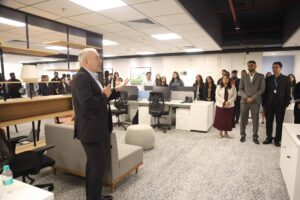One of my core mantras is that in digital transformation the strategy must always be delivery. You can have the most powerful technologies, the most refined integrations between platforms, and the most well-structured data system but until students and staff can use it, there’s no benefit.
And while we might all be comfortable with digital in terms of our expectations of a seamless user experience when we engage with digital technology, our digital skills can be uneven. That means that universities’ digital strategy has to include investment in improving digital skills across the whole community. Digital strategy stands or falls on whether students and staff can use digital technologies confidently and creatively to get better outcomes from their learning, teaching, research and administrative activities.
Digital skills are typically thought of as being something for HR, or for the university library or learning support units, whereas it’s the job of CIOs and their teams to build or buy the technologies with the right capabilities to serve the university’s core administrative processes and functions. This traditional siloed approach leads to poor alignment between the technologies in use within an institution, and the learning outcomes of its students.
Trying to convince students that digital capabilities are one of their graduate attributes when nothing seems to work in the university itself is a pretty hard sell. We want the organisations that students are learning in to reflect the environment they will be (or already are) working in. In the Goldsmiths context we want students to learn how to integrate creative practice into their daily activities, as part of the tools they develop to be critically engaged with the world.
Strategic skills
Ideally, strategies need to achieve alignment between the capabilities of the technology infrastructure, the skills of the people using those technologies, and the platforms they are using to access them. This kind of alignment creates the best conditions for people to grow in confidence in using digital tools to communicate, solve problems, find more efficient workflows, and so on.
It must be said, in a university setting this is much more complicated than in a commercial one, or even some public sector contexts. Most organisations are set up to do one core thing: sell products, or provide services. Decision-making about digital investment is therefore guided by whether it helps you sell more product, or provide higher quality services to more people. Universities do many different things, and there is rarely one single overall goal that is driving resourcing decisions. So external partnerships that address those foundational and skills considerations are in some ways more important than the selection of a particular platform that will likely be redundant in five years.
Being an Adobe Creative Campus opens up a number of opportunities for us that help achieve this strategic alignment and focus on digital skills. Giving staff and students universal access to tools like Firefly and Adobe Express means there’s no question of anyone being excluded on the grounds of cost or licensing exclusions – everyone is accessing the same toolkit.
Connected curriculum
In the classroom, it has enabled Goldsmiths to roll out a multi-modal assessment option as part of our Connected Curriculum initiative, which offers students in participating courses four core modules in years one and two of their degrees that create opportunities for students to develop their personal and academic agency. Students are offered the choice between completing an assessment in the traditional essay style, or taking a multi-modal approach, using video, podcasting or presentation tools alongside a reflective log.
Obviously the availability of generative AI tools that can churn out a traditional essay in minutes is one of the drivers for this change but the larger picture is about recognising that as we all operate in a multi-modal landscape, long form prose is not always the most impactful way of getting your point across. Pedagogically, being forced to think about how to present information and ideas in a multi-modal format is often more challenging than a simple essay format.
The challenge involved also explains why students can often be quite daunted by the notion of multi-modal assessment in the first instance, and worry they cannot develop the skills – but if anything that is more of a reason to do it, with the right support. And we have found that assignments produced using multi-modal assessments have achieved higher grades, staff have reported they enjoy marking them more as well.
Embedding multi-modal assessments in the Connected Curriculum modules has been the objective for Year One of our time as a Creative Campus; in Year Two we plan to roll the approach out more widely. The aim is that by the end of their third year students are proficient in using the tools they will need to use in the modern workplace, as well as actively enjoying the challenge of using those digital skills to challenge themselves and exercise their creativity.
Investing in digital capabilities
But the wider digital skills implications extend beyond students in the classroom to the wider university community. The raw material in terms of staff capability in the higher education sector is the highest I have ever seen – there is no shortage of smart people and talent, which is very different from other sectors. So the digital deficit that many institutions seem to struggle with is more attributable to cultural factors and institutional complexity than to individual competence. Good strategy can help to overcome some of that complexity so that staff can start to use digital tools and data to make their lives easier, and more creative – with knock-on benefits for students.
One day, I think we will not need “IT teams” at all, as digital upskilling and keeping abreast of developments in technology become integrated as part of business as usual across organisations. Until that day comes though, I’ll keep ensuring that our organisational digital strategy achieves that close alignment across technology, data capability, digital skills, and user outcomes. It pays to think of it like a trifle, with all the layers supporting each other – rather than an Eton mess where they are all mixed up.
This article is an edited version of a talk given at an Adobe Creative Campus Collaboration event in June 2024. You and find out more about how Goldsmiths University is rolling out its Creative Campus agenda in this video.




